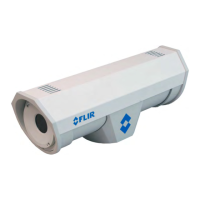
Do you have a question about the FLIR F-Series and is the answer not in the manual?
Important safety warnings and cautions regarding camera handling and operation.
Lists related documents for further information on mechanical and configuration aspects.
Provides a general description of the F-Series camera's capabilities and connections.
Explains the general installation process and camera mounting considerations.
Details the various connection types available for the camera, including power and video.
Lists the standard components included with the F-Series camera.
Lists the items that the installer needs to supply for the installation.
Discusses factors to consider when choosing a mounting location for the camera.
Instructions for performing a bench test to verify camera operation before final installation.
Guidance on planning for cable routing and ensuring sufficient cable length before drilling.
Specifies the correct orientation and method for mounting the F-Series camera.
Step-by-step guide on how to safely remove the camera's back cover.
Details the importance and process of properly sealing cable glands for water-tightness.
Describes the contents of the cable glands and spare parts kit provided with the camera.
Explains the cable gland seal inserts and how to use them for different cable diameters.
Provides a diagram and explanation of all camera connection points.
Details how to connect the power supply to the camera, including grounding requirements.
Explains how to connect the analog video output using BNC and RCA connectors.
Specifies the type of Ethernet cable required for network connectivity.
Details how to connect and configure the serial interface for communication.
Discusses the methods for configuring serial communication settings (hardware vs. software).
Explains how to use the DIP switches to configure serial communication parameters.
Lists the technical specifications for the F-Series thermal cameras.
Introduces the Nexus IP camera and its architecture, including Nexus Server software.
Discusses general configuration needs for Nexus IP cameras, like IP settings.
Explains how cameras communicate via serial or IP networks for control and data.
Details the serial communication protocols and default settings for the camera.
Covers IP network communication for video streaming and configuration via web browser or FSM.
Recommends testing the camera with the same connections as the final installation.
Provides a step-by-step guide for performing IP communication testing and configuration.
Explains how to access and use the camera's web interface for configuration and monitoring.
Instructions on how to access and log into the camera's web interface.
Explains how to view camera status and request control for operation.
Describes the control buttons available in the web interface for camera operation.
How to access help information, including version and part numbers.
Instructions on how to safely log off from the camera's web interface.
Guidance on performing a bench test using FLIR Sensors Manager (FSM) software.
Steps to install and run the FLIR Sensors Manager (FSM) software.
Describes common configuration steps like setting IP address and passwords.
Explains the roles and access levels of the expert and admin user accounts.
Accessing the maintenance menu for system status, LAN, services, and security.
How to configure hostname, gateway, and IP address via the LAN settings.
Configuring date, time, and time zone settings using NTP or manual entry.
Setting passwords for user accounts and restricting IP access to the web interface.
Managing camera configuration files, including backup, restore, and upload.
Explains the principles of thermal imaging and how the camera produces images.
Provides solutions for common issues like image freezing, no video, and performance variations.
Discusses general errors in FSM and how to view error messages and logs.
Addresses issues with viewing video streams in FSM, including firewall and codec problems.
Explains why images might appear too dark or too light and how to adjust.
Procedures for restoring the camera to its original factory default settings.
Step-by-step guide on how to configure a Windows PC's IP address for network connection.
Provides a table for converting serial addresses between decimal and binary formats.